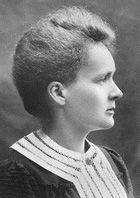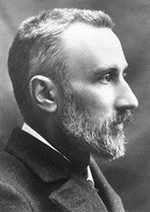 | Marie Sklodowska was born in Warsaw, Poland, on November 7, 1867. The Sklodowskas were members of the impoverished Polish bourgeoisie. Her father struggled to support his large family as a high school teacher of physics and mathematics. He was apparently a brilliant man, and Marie learned both from his example and from his hands-on teaching. But her mother suffered from tuberculosis and, hoping to spare her children, decided one day she could never touch them again. Marie was five years old at the time, and it is thought that her lifelong aversion to public displays of affection sprang from being denied physical affection as a child. | |
At age nine, she was greatly pained by her mother's death. From 1885 to 1889, she selflessly worked as a governess, sending her earnings to her older sister, Bronya, who was studying medicine in Paris. Then, when her own turn came at the Sorbonne, she hit the books with a ferocious determination, graduating first in her class--the first woman to earn a Licienciée ès Sciences Physiques. | ||
 | Marie's life blossomed personally and professionally when she met Pierre Curie, born in Paris, France, in 1859. a brilliant young French physicist., who became a professor at the Sorbonne. His early work concerned the electric and magnetic properties of crystals; he enunciated Curie's law relating magnetism and temperature. They were married in 1895. He joined in her work on radioactivity. Together they decided to further A.H. Becquerel's investigation of the radioactive properties of uranium. For the scientific world, 1898 was a turning-point year -- thanks to the Curies. | |
| In July, they announced the discovery of a new radioactive element, POLONIUM (named by Marie after her motherland); in December, they announced their discovery of RADIUM. Their next step was to isolate both elements. Poorly equipped and underfunded, they spent the next three years doing precisely that. They were awarded jointly half of the Physics Nobel Prize in 1903. [The other half went to Henri Becquerel]. She was the first woman to win the award.
After Pierre's death in a road accident, Marie succeeded to his chair and received a second Nobel Prize in Chemistry for her discovery of Polonium and Radium in 1911. Pierre died in 1906, and Marie died in 1934. | ||
To return to where you were, please use the BACK button of your browser.